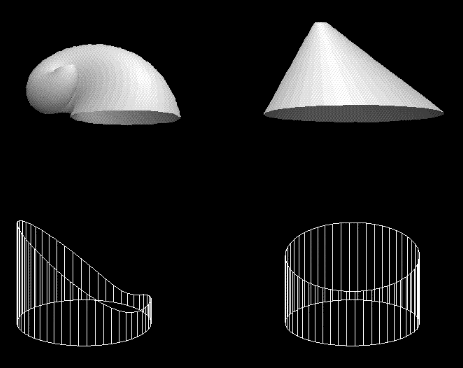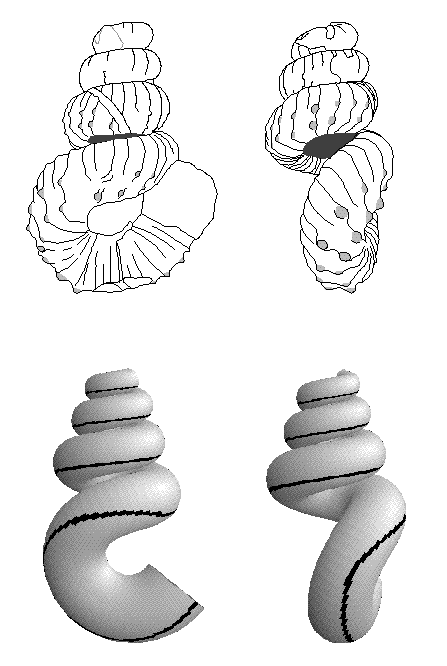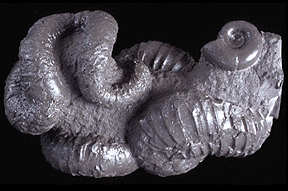The Bio-Geometry of Shells
Sean Rice
Dept. of Ecology & Evolutionary Biology
Yale University
The form of most gastropod and cephalopod shells is defined
if we specify four developmental properties. 1) The pattern of
shell production around the aperture; 2) the total amount of
shell produced per time; 3) the growth rate of the aperture, and
4) the shape of the aperture. By using these developmental
parameters, we can look at two shells and ask what developmental
changes would be necessary to transform one into the other.
For example, consider this sequence of shells.

In the drawings below the shells, the vertical lines represent
rates of shell production at different points around the aperture
(which is circular). The solid lines are the actual rates of
shell production. Clearly, the move towards the limpet like form
on the right involves reducing the total amount of shell produced
per time interval. In order to compare the pattern of shell
production, I have drawn in dashed lines for the middle and
righthand shell that represent the rates for those shells
multiplied by constants (2 and 5, respectively). We can see that
the shapes of the shell production functions are nearly
identical. Thus, a slightly coiled limpet like the one on the
right can evolve from a highly coiled ancestor simply by reducing
the total amount of shell material produced, with no change in
the relative behavior of different cells around the aperture.
Many limpets are not coiled at all, and we might ask
whether
a perfectly conical limpet could be derived from a coiled
ancestor in a similarly easy way. Here are the shell production
functions for the slightly coiled limpet shown above and a
completely conical one.

Note that here, we must completely change the pattern of shell
production, and thus the relative behaviors of different cells in
the mantle.
Thus, it should be relatively easy to evolve a partially
coiled limpet from a highly coiled ancestor. Going all the way
to a perfectly conical form, though, requires a radical change in
development. It is thus not surprising that in the history of
gastropods, partly coiled limpets have evolved many times (around
14, at last count), whereas truly conical limpets have only
arisen 4 times.
This model also helps us to understand the evolution of
radically different shell forms.
A number of ammonites exhibited complex growth forms that often
changed direction at specific stages. Lumped together as
"heteromorphs", these animals clearly had found ways to break the
rules followed by most shelled molluscs.
Below are two views of a specimen of Didymoceras (from
the Peabody Museum collection), a
heteromorph that began life as a conico spiral and then abruptly
switched to a different growth pattern.

At first glance, this would appear to require a radical change in
the growth process. In fact, neither the pattern of shell
deposition nor growth rate need change at all during the growth
of this animal; all that is needed is for the animal to rotate
its body within the shell.
The lower figures illustrate the consequences of such a
rotation. At the start of the fourth coil, the animal begins to
rotate clockwise (relative to an observer inside the shell
looking out) within the shell. This has the effect of shifting
the axis of coiling and causes the shell to grow downward. After
rotating through an angle of 1.2 radians, the animal begins to
rotate back (counter clockwise). This is what would happen if
each point around the mantle lip continued producing new shell
material at the same relative rate that it always did. The black
line represents the strip of shell laid down by a particular
point on the mantle.
Some conformation that this story describes what
Didymoceras actually did is provided by sculpture on the
shell. The specimen shown above has two rows of knobs (shaded in
the figure) running along the outer part of each whorl. As the
shell begins its aberrant growth, these knobs follow the same
kind of trajectory shown by the black line in the lower figures -
rotating first to the outside of the loop and then ending up on
the bottom. This is exactly the path that would be taken by the
mantle tissue underlying the knobs in the upper whorls if the
animal rotated as hypothesized.
Another heteromorph, Nipponites, used this trick repeatedly
to produce a shell (shown below) with no axis of coiling at all.

For further discussion of this topic, see:
Rice, S. H. 1998. The bio-geometry of mollusc shells.
Paleobiology 24:133-149.
Get a PDF reprint (1297 Kb).
 Go to Sean Rice's page
Go to Sean Rice's page
Jul 8, 2021


